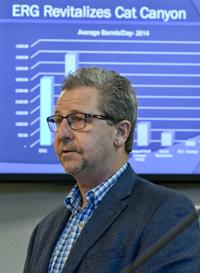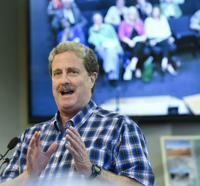After more than four hours of public testimony Wednesday, the Santa Barbara County Planning Commission continued a public hearing on the ERG West Cat Canyon Revitalization Plan that would add 187 new steam-injection oil wells and a new natural gas pipeline to the company’s existing operation.
Commissioners unanimously agreed to continue the hearing to the March 27 meeting, which was scheduled to take place in Santa Barbara but staff said could be held in Santa Maria again.
More than 100 people packed the Supervisors Hearing Room and spilled into the lobby of the Joseph Centeno Betteravia Government Building, where about 50 protesters with signs gathered outside at 8:30 a.m. before the meeting.

Environmental Defense Center staff attorneys Alicia Roessler, left, and Tara Messing confer during a Santa Barbara County Planning Commission hearing Wednesday on proposed changes to the ERG West Cat Canyon oil fields.
The purpose of the hearing was for the Planning Commission to determine whether the environmental impact report for the project is adequate and, if so, to certify the document; make the findings necessary to approve the project and, having made those, approve the project described in Alternative 1.
That alternative is 20 percent smaller than the 233-well project ERG originally proposed for the site.
ERG officials agreed to seek approval for the smaller project after it was recommended by the County Planning & Development staff based on the results of the EIR.
Alternative 1 calls for 187 new steam-injected oil and gas wells on 91 existing pads — nine of which would be expanded —along with four new steam generators, new pipelines within the field and support equipment on about 75 acres of ERG’s 8,054-acre property in West Cat Canyon.
“The basic premise is the oil is very thick,” Errin Briggs, the county’s supervising planner for the project, explained about the cyclic steam-injection process. “It’s very viscous, so it must be heated to make it flow to the surface.”
In addition, a new 8-inch-diameter, 3.5-mile-long natural gas fuel pipeline is included in the project to provide fuel for routine field operations, although an existing 4-inch line would remain in place as a backup.
Commission Chairman John Parke, representing the 3rd Supervisorial District, warned the audience it could take several hearings before the commission reaches a decision on the EIR and project as he laid out the ground rules for public testimony.
Parke said the focus should be on the adequacy of the EIR, but comments from many who spoke in opposition to the project ranged from global warming and the need for solar power to ERG’s financial situation and problems created elsewhere by other companies.

COLAB Executive Director Andy Caldwell speaks in favor of the ERG West Cat Canyon Revitalization Project during a Santa Barbara County Planning Commission hearing March 13, 2019.
About 60 people offered testimony, with those opposed outnumbering those in favor by about 2-to-1, but that likely belied the actual support.
Alan White, chief executive officer of ERG Operating Co., said the company had a number of supporters in the audience but had not asked them to speak. However, when he asked them to stand to show support, more than half the audience rose from their chairs.
White also ran through what he said was misinformation being circulated about the company and the project — that ERG owed the county back taxes, had spilled the most barrels of oil in the county and was injecting polluted wastewater into the aquifer.
Nathan Eady, vice president and project manager for SCS Engineers, also highlighted some aspects of the project, including that only 6 percent of the land would be disturbed and the northwest portion of the property would be restored to a native oak woodland.
Eady said the project would benefit the economy by providing 200 jobs that would pay an average of $100,000 each annually, and the company would assist in a transition to renewable energy by installing new charging stations for electric vehicles.
He also said the company could mitigate about 250,000 metric tons of carbon dioxide emissions to reach the county’s threshold through methane lead detectors and improvements to the steam-injection process.
“We believe the best mitigation is to have no impact at all,” Eady said.
However, the EIR identified three significant and unavoidable Class 1 environmental impacts that even the smaller project couldn’t eliminate.

Rebecca August, representing Safe Energy Now, North County, at Wednesday's Santa Barbara County Planning Commission hearing, shows some of the 5,000 postcards that organization and others collected from individuals opposed to the ERG West Cat Canyon Revitalization Project.
One was the potential for oil spills to degrade the habitat for threatened and endangered species and rare plants, and another was the potential for spills to degrade water quality.
The third was for noise from construction and drilling to exceed county limits at surrounding homes.
But opponents slammed the EIR as inadequate.
Staff attorneys for the Environmental Defense Center, representing 38 other local organizations, provided about 20 minutes of testimony in tag-team fashion, claiming the EIR failed to meet the requirements of the California Environmental Quality Act and failed to list numerous Class 1 impacts.
“The EIR is so deficient it’s unable to meet CEQA requirements,” Alicia Roessler said. “It fails to identify … and mitigate Class 1 impacts. The project’s description is legally inadequate and conceals its true scope and magnitude.”
In addition to oil, spills of produced wastewater and other hazardous materials from new wells, trucks, pipelines and production facilities threatened surface and groundwater as well as California tiger salamander and California red-legged frog breeding habitat, the EDC attorneys said.
The draft environmental impact report on the proposed Aera East Cat Canyon Oil Field Redevelopment Project has been released by the Santa Barb…
Greenhouse gas emissions would threaten human health and contribute to global climate change, they said, and the EIR failed to include the total amount of fresh water that would be used for drilling, construction and operations.
They charged that 156 one-way tanker truck trips per day will pose a safety risk to the public through crashes and would degrade local roadways.
Tara Messing said that over the 40-year life of the project, “more than 30 billion gallons of toxic wastewater” would be injected into groundwater.
Brian Trautwein said the EIR used surveys that were four to eight years old, exceeding the time limit allowed by CEQA, and that other surveys were conducted during the drought when species were not present.
The EDC lawyers also said the EIR failed to adequately consider the cumulative impacts of the adjacent PetroRock and Aera Energy projects as well as ERG’s existing operation and did not include another 20 projects they said they uncovered.
“There’s nothing to prevent ERG from drilling beyond 40 years,” Linda Krop said, adding the EIR “failed to analyze alternative energy” projects.
Speaking in rebuttal, Andy Caldwell of the Coalition of Labor, Agriculture and Business said the commission should look at the broader picture.
“CEQA has the ‘no project’ alternative,” he said. “Usually that means ‘no project.’ But in this case, the ‘no project’ alternative is the existing project. … It has no mitigations.”
He claimed without the project, there would be no reduction in greenhouse gas emissions. But with the project, the emissions would go to zero as a result of mitigations.
At least 120 people turned out Monday night for a workshop in Santa Maria to gather public comments on the draft environmental impact report f…
“The North County is a resource-based economy. We don’t want an underclass,” he said, adding the project would allow people with a high school education or less to earn $100,000 a year.
Caldwell also defended those who prepared the EIR.
“These guys spent four years going through the most rigorous process in the nation,” he said. “They dotted every ‘i’ and crossed every ‘t’ your staff asked them to do.
“I believe the EIR is adequate and certifiable.”
Rebecca August, representing Safe Energy Now, North County, urged the commission to fully evaluate the project.
“We will all bear the impacts this project will have on our county for the next 30 years,” she said.





























